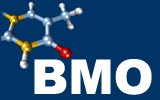|
Design principles of a NOPA
A NOPA
is an optical parametric converter designed to generate ultrashort tunable visible pulses
from blue pump pulses. The tuning range is 470 to 1600 nm for pumping with a fre-quency doubled
Ti:sapphire amplifier system. Most NOPAs are used at kHz repetition rate, but we have also built
units for up to 200 kHz and for just a few 10 Hz. In the visible the spec-trum of the pulses can
be made sufficiently wide to support sub-10 fs pulses. Sub-30 fs pulse lengths are readily
available by compression in a simple prism compressor made of SF10 prisms. In the NIR sub-50
fs pulses are generated.
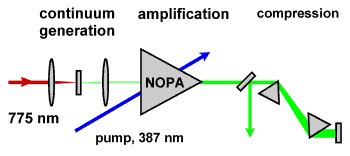 A single-stage N
OPA
consists of three main functional blocks:
A single-stage N
OPA
consists of three main functional blocks:
- Continuum generation in a sapphire disk pumped by a small fraction of the NIR pump light.
- Parametric amplification of the seed light in a BBO crystal pumped by the frequency doubled pump light.
- Compression of the broadband output pulses.
Pulse lengthening in collinearly phasematched OPA
In an optical parametric amplifier (OPA) photons contained in a short wavelength (blue) pump beam
are split into one signal (visible) and one idler photon (NIR) each. The "active" medium is a
nonlinear optical crystal, such as BBO. For efficient conversion the phase veloci-ties of pump,
signal and idler are matched by proper rotation of the birefringent crystal. Un-fortunately, however,
this does not simultaneously assure matching of the three group veloci-ties. Therefore the three
pulses propagate at differing speeds in the crystal and as a result the amplified signal and idler
pulses exiting the crystal are typically 100 fs long for collinear phase matching in a 1 or 2 mm
BBO crystal.
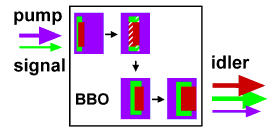 The situation is illustrated in the Figure. A 100 to 150 fs long pump pulse (violet) propagates
through the crystal and a very short visible seed (signal; green) pulse is injected in addition.
This signal pulse is amplified by the parametric interaction and an infrared idler pulse (red) is
generated at the difference frequency between pump and signal. This idler pulse propagates somewhat
faster than the signal. Continuously signal and idler are amplified as they travel fur-ther through
the crystal and the signal generates more idler just as the idler generates more signal (shown as
hashed areas in the Figure). Due to the differing group velocity, the new sig-nal photons are added
on the leading edge of the signal pulse and the new idler photons are added on the trailing edge of
the idler pulse. As a result lengthened pulses cannot be avoided in collinearly phasematched visible OPAs.
The situation is illustrated in the Figure. A 100 to 150 fs long pump pulse (violet) propagates
through the crystal and a very short visible seed (signal; green) pulse is injected in addition.
This signal pulse is amplified by the parametric interaction and an infrared idler pulse (red) is
generated at the difference frequency between pump and signal. This idler pulse propagates somewhat
faster than the signal. Continuously signal and idler are amplified as they travel fur-ther through
the crystal and the signal generates more idler just as the idler generates more signal (shown as
hashed areas in the Figure). Due to the differing group velocity, the new sig-nal photons are added
on the leading edge of the signal pulse and the new idler photons are added on the trailing edge of
the idler pulse. As a result lengthened pulses cannot be avoided in collinearly phasematched visible OPAs.
Noncollinear phasematching for ultrashort tunable pulses
Work by G. M. Gale and coworkers (Opt. Lett. 20, 1562 (1995)) demonstrated an elegant solution to
the problem of pulse lengthening in collinearly phase matched parametric interaction. They used a
noncollinear arrangement in a quasi-cw pumped visible OPO that produced sub-20-fs pulses. This is
made possible by the following situation. The chosen noncollinear ar-rangement of pump and seed
(signal) beam - angle ? - results in an angle O between the idler and the signal that is
approximately given by

The idler group velocity is somewhat larger than the signal one and therefore a suitable angle O
can be found that the projection of the idler group velocity onto the signal k vector (propagation
direction) will match the signal group velocity, i.e.
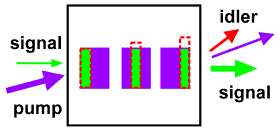

This situation is illustrated in the Figure. Now the extra signal photons generated by the amplification
of the idler are produced at the same position as the ones due to amplification of the signal itself
and no lengthening of the pulse results. The transversal displacement of the idler only leads to a
slight spatial widening of the signal beam.
It can easily be shown that effective matching of the signal and idler group velocities is equivalent
to very broadband phase matching in the parametric process (Appl. Phys. B 71, 457 (2000)). As a consequence
a very wide spectral range out of the seed light can be amplified and the resulting output pulse can be
compressed to pulse lengths well below 10 fs.
For calculations of the phase matching angles in the noncollinear parametric interaction a program
SNLO written by Arlee Smith is most helpful.
Any angles and geometries needed for the alignment of the
N
OPA
can easily be calculated with the help of this program. In the original OPO reported by Gale the tuning
range was limited by the resonator optics and the operation of the OPO depends critically on a very high
average pump power. Wilhelm, Piel and Riedle were the first ones to show that a traveling wave
noncollinearly phase matched OPA pumped by blue pulses at 1 kHz repetition rate can readily yield sub-20-fs
pulses tunable throughout the visible (Opt. Lett. 22, 1494 (1997)).
Generation of the chirped seed continuum
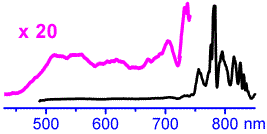 Hard focusing of less than 1 ?J of 100 fs 800 nm pulses into a sapphire disk leads to self focusing
and generation of a single filament continuum. The visible part of the spectral distribution of such
a continuum is shown in the Figure. In the range from about 460 to 700 nm a nearly flat distribution
is found that allows the use of this continuum as seed light for the
N
OPA
. The continuum pulse is
strongly chirped due to the dispersion in the sapphire itself and the optics used to collimate the
emerging beam. In addition the continuum propagates somewhat faster than the blue pump pulse in the
amplifier crystal. This slippage and the continuum chirp can be matched to select both the desired
center wavelength of the output pulses (choice of pump - seed delay) and the bandwidth of the pulses.
Hard focusing of less than 1 ?J of 100 fs 800 nm pulses into a sapphire disk leads to self focusing
and generation of a single filament continuum. The visible part of the spectral distribution of such
a continuum is shown in the Figure. In the range from about 460 to 700 nm a nearly flat distribution
is found that allows the use of this continuum as seed light for the
N
OPA
. The continuum pulse is
strongly chirped due to the dispersion in the sapphire itself and the optics used to collimate the
emerging beam. In addition the continuum propagates somewhat faster than the blue pump pulse in the
amplifier crystal. This slippage and the continuum chirp can be matched to select both the desired
center wavelength of the output pulses (choice of pump - seed delay) and the bandwidth of the pulses.
Need for pulse compression
The broad bandwidth output pulses of the
N
OPA
are chirped due to the initial chirp of the seed
continuum and additional chirp caused by the dispersive properties of the BBO crystal, the optics
and the air. The chirped pulses can readily be compressed in a simple compressor made of two prisms
that are double passed. With SF10 prisms a pulse length below 30 fs can be reached throughout the
tuning range with a small spacing of the prisms. To get down to 10 fs fused silica prisms are needed
with a spacing around 1 m.
Note: Even the compression of the pulses in the prism sequence only minimizes their length at one
single point in space. Transversal of further optics - including plain laboratory air - will cause
the pulses to lengthen again. This means that the pulse length has to be determined in the spot of
the spectroscopic experiment or an equivalent position. The prism
compressor can, however, be well
used to precompensate the chirp encountered downstream.
Commercial availability
In a very fruitful collaboration with HORIBA Jobin Yvon
(Dr. Hans-Erik Swoboda) and
Clark-MXR, Inc. we have
developed a series of boxed NOPAs that have been installed in leading laboratories around the world.
The single-stage NOPA described so far is available as
NO
PA
slim.
Its fundamental tuning range of 470
to 700 nm can be extended by different means:
-Wavelengths between 870 and 1600 nm can be generated with high pulse energies and high efficiency
in the 2-stage
NO
PA.
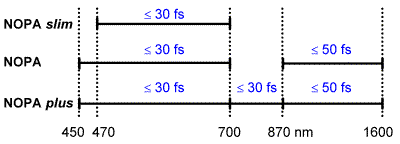 -To generate ultrashort pulses in the 700 to 870 nm range, suitable seed light has to be generated.
The continuum generated from the 775 nm CPA output is strongly structured in this range and therefore
not suited. In the 2-stage
N
OPA
plus
the first stage is operated in the NIR and the output is used to
pump a second continuum. Selected portions are then amplified in the second stage.
-To generate ultrashort pulses in the 700 to 870 nm range, suitable seed light has to be generated.
The continuum generated from the 775 nm CPA output is strongly structured in this range and therefore
not suited. In the 2-stage
N
OPA
plus
the first stage is operated in the NIR and the output is used to
pump a second continuum. Selected portions are then amplified in the second stage.
-To access the UV and deep blue range (240 to 470 nm) the
NO
PA output can be fre-quency doubled or
sum frequency mixed with the Ti:sapphire fundamental in a thin BBO crystal. Pulse lengths well below
30 fs are obtained with typically 10 % conversion efficiency.
For the analysis of the ultrashort pulses we developed a
compact autocorrelator
(N
OPA
pal)
that can measure pulses as short as 10 fs in the range from 420 to 1600 nm.
| 
